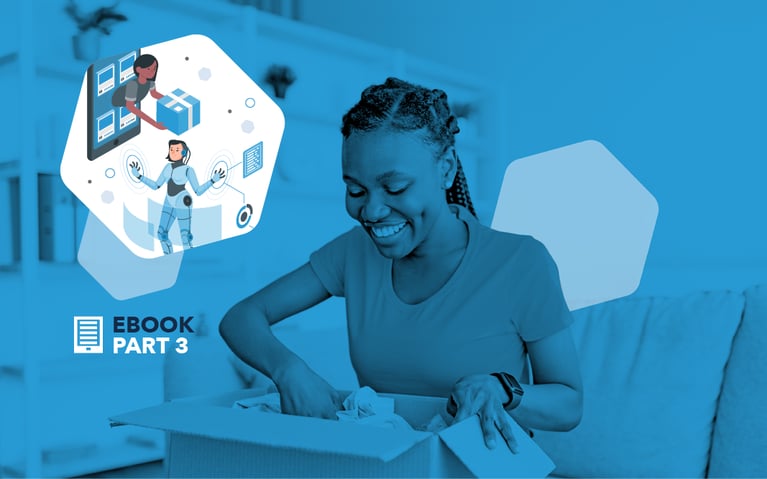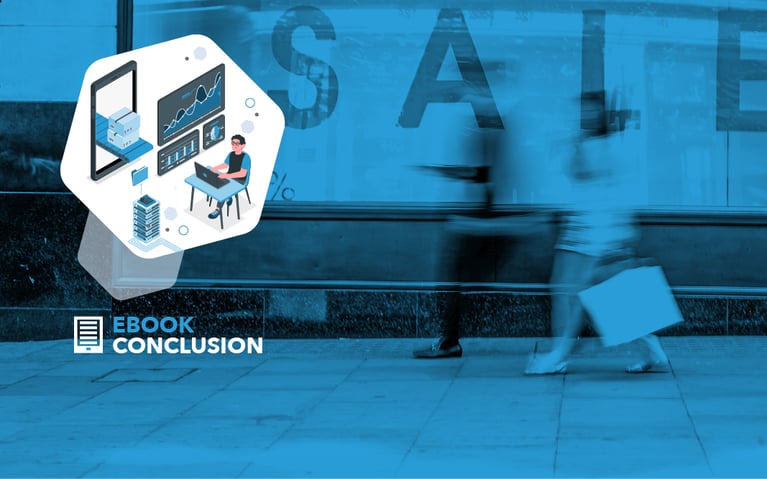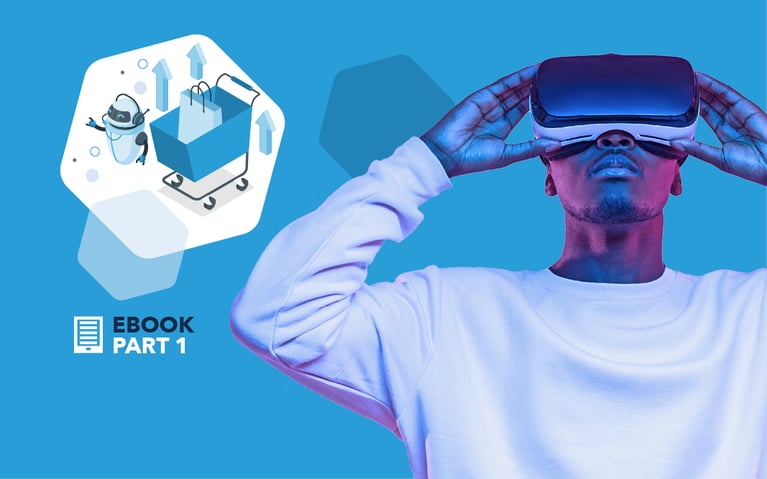Two+ years into the pandemic, the energy inside the show was palpable. There was so much pent-up hunger to be surrounded by the biggest and boldest minds looking to cover the latest technologies, trends and transformations that impact how we all shop and buy products.
Having only launched our business 14 months ago—while the Cart.com team made our grand entrance with an out-of-the-box booth design and showcasing our full-stack B2B commerce platform, I split time attending as many shows as possible.
Throughout the course of 3+ days of content sessions, there were tons of key themes that shook out, but there are a few that I wanted to share with you.
1. NFTs, the metaverse and alternative payment methods
The topic was inescapable, it popped up in every single session. As a preface, I am by no means an expert in this space, not even close- these are merely my observations. While many brands and online retailers were late to the party on digital transformation and building out a true omnichannel shopping experience, it’s clear these same brands and retailers refuse to be late again. While the Metaverse means different things to different people, and whether this becomes a long-term reality, brands are jumping in headfirst and finding unique ways to experiment in this space. Here are a few use cases that stood out:
Leveraging the sale of NFTs to bring in new customers, build loyalty, and experiment with alternative payment methods to drive customer engagement. Interestingly, Forrester shared that 25% of US customers used an Alternative Payment method in 2021 and that by adding these payment methods, you are 40% more likely to attract new customers, while also increasing basket size by almost 30%. While the above stat can include the ever so buzz worthy mention of Buy-Now-Pay-Later (BNPL) through services like Affirm or Klarna, John Strain (Chief Digital and Technology Officer, Gap Inc.) shared that Gap Inc. drove 21,000 Crypto sign-ups from an NFT drop of ‘Common’, ‘Rare’, and ‘Epic’ variations. There was a gamification aspect where to be eligible to purchase ‘Rare’ or ‘Epic’ NFT’s, you needed to first purchase 4 ‘Common’ NFTs to be eligible. This reminded me of my own personal NFT experiment on NBA TopShot- it’s the same overall model.
Another example is utilizing the Metaverse to showcase your products that traditionally are better suited for in-store exploration where you want to touch and feel what you’re buying (e.g., furniture). Bob Sherwin (Chief Marketing Officer, Wayfair) shared that companies need to focus on consumer problems that can be solved with augmented reality and the Metaverse. For example, they’re creating photo-realistic 3D models that allow people to view furniture in rooms for spatial awareness, while recycling these 3D models to save money on photo shoots and increase their velocity of content creation.
Now you might be asking yourself, how prevalent are shoppers in this virtual world? According to Cowen 1 in 4 consumers have shopped in a virtual store with 70% having made a purchase. Even more profound, ~60% of Gen Z consumers believe that brands should sell products in the Metaverse.
Key takeaway: NFT’s and alternative payments can help drive new customers, create a gamified loyalty experience, and create unique ways to drive customer engagement.
2. First-party data is more important than ever
The evolving Privacy landscape is causing a massive shift in how organizations view data and 1:1 personalization. By now, we’ve all heard about how the Apple iOS changes have already impacted advertising revenue on Facebook in a big way. We’re also all eagerly waiting on Google to implement their policy changes on Cookies. These types of monumental shifts in how Marketers attract and convert customers cannot be overstated. So how are organizations reacting? A renewed focus on first-party data.
Companies are using geo-spatial analytics of products purchased (online and in-store) to create demand forecasting models via machine learning and advanced AI that help predict SKU levels and what types of products are being purchased, and where. For example. Steve Miller (SVP, Strategy, eCommerce & Analytics- DICK’s Sporting Goods) shared that when COVID-19 caused geographic restrictions on physical activities, as kids began playing Soccer in Northern California, but there were pro-longed shutdowns in Southern California, both inventory and marketing campaigns were shifted to specific regions. So, while not personal at a 1:1 level, the usage of first-party data to drive intelligent inventory and micro-targeted marketing efforts can still create that sense of personalization for the end consumer. This was also reinforced by Jenny Campbell (Chief Marketing Officer, Kate Spade) and how crucial it is to work through repeat purchase data and geographic trends to shift inventory based on demand trends. She further leaned into this by stressing the importance of organic social content and engagement and the correlations back to purchasing data and inventory management.
Another example of how organizations are using first-party data to drive personalization is diving into their POS and customer purchase history to dial in 1:1 marketing efforts (e.g., recommendations). Yasir Anwar (Chief Technology Officer and Digital Officer, Williams-Sonoma) believes that successful brands and retailers will need to transform themselves into data and engineering companies to harness the power of first-party data. He stressed the importance of testing, failing fast, and committing to where you’re seeing things work. In fact, Yasir explained that Williams-Sonoma is so committed to testing, they’ve built out a proprietary ‘test-kitchen’ to create, manage, and execute robust product testing across the shopping journey.
Key Takeaway: Being able to understand your customer funnel, purchase history, geographic nuances, and testing will continue to play a critical role as privacy policies continue to restrict our ability to execute 1:1 targeting that everyone has been so spoiled with over the years.
3. Brick & mortar is roaring back - and innovating
By now it’s no secret, brick and mortar is back as COVID-19 waves slow down and we all break out of our cages. Throughout the conference there were some profound takeaways and innovations as to how the in-store shopping experience is being both utilized and re-imagined.
One thing the pandemic certainly defined is what it means to be a strong operator. Being able to use your physical store(s) as a tool for online purchases to execute curbside pickup, returns, or fulfillment are a few key examples. To put this in perspective, DICK’s Sporting Goods is fulfilling 70% of their ecommerce sales via their physical stores according to their ecommerce analytics and Wayfair is opening their first ever brick and mortar retail location(s) in 2022 to round out the omnichannel shopping experience.
In addition to the above use cases, one of the many new ways in-store innovations are taking place is turning your visit into an experience. I’m not talking about ordering the infamous Swedish Meatballs at Ikea experience, but more in the camp of Steve Miller (SVP, Strategy, eCommerce & Analytics- DICK’s Sporting Goods) sharing their ‘House of Sport’ concept. This allows athletes to now sample equipment ranging from shoes to baseball bats, to tennis racquets at massive onsite fields prior to making a purchase. At the end of the day, according to Oracle 80% of customers still like to go in-store simply because it makes them happy.
Another key area of innovation is the payment and checkout experience. Problems lead to solutions and that’s exactly what happened to founder and CEO Mustafa Khanwala, who was so annoyed waiting in line for 10 minutes to buy a Coca-Cola he created MishiPay, a scan-and-go seamless checkout experience that eliminates queues, reduces costs, and increases customer satisfaction via mobile self-checkout. Another more popular example is Zipline, who is addressing both customer and employee issues simultaneously. By enabling store teams and associates to go mobile, be more tuned in to corporate pricing and discounting strategies, they’re empowered. This is not only increasing employee sentiment, but also customer satisfaction by allowing the same individual that handles your product questions, to check you out at time of purchase.
Key Takeaway: Physical locations are being used as fulfillment hubs, in-store visits that are experiential can increase purchase decisions, and payment technologies are streamlining operations.
4. Impulse purchases & live shopping
Lastly, I wanted to touch upon the recipe for impulse purchases and the growth of live shopping. According to Ipsos, 64% of US adults have made at least one impulse purchase online through a digital channel in the last 3 months, with 20% occurring because of social media and 25% occurring through recommendation engines on brand or retail websites. When thinking about impulse purchases, it’s important to think about where to be (marketing channels), when to be there (dayparts such as late at night), and how to play there (optimize for touchscreen, fast and frictionless transactions).
This takes me right into the future of impulse buying and what has the potential to become a mainstream marketing channel, Live Shopping. An extension of social commerce through TikTok, Instagram Pinterest, Facebook, etc. - Live shopping is wildly successful in Southeast Asia (44% of shoppers are used to making purchases via Live Shopping program-Ipsos). These shows generate fun and engaging ways to drive purchase behaviors through content creators that steer conversion rates. These shows are not just about shopping, they’re entertainment. There’s a certain level of storytelling and authenticity that plays into the sensory aspects of purchasing behavior. Don’t believe this concept has legs? Walmart has entered this space and just launched their Walmart Live platform and there are platforms to purchase popping up everyday.
So why has adoption in the US been slow? Aside from cultural differences between Asia and the U.S., adoption has been somewhat hampered by integrations and friction throughout the checkout process. However, as Headless Commerce continues to expand and platforms like Taobao Live are available for a plug and play integrated solution, the pieces are in place for the next big Marketing channel in the U.S.
Key Takeaway: Get ready to hear more and more about Live Shopping and experiment for yourself so you can go through the end-to-end consumer experience.
Conclusion
I’ll end where I started. It was amazing to be back in person with so many like-minded individuals sharing the latest and greatest ideas that transform how we all shop for products. Shoptalk is always referred to as the "Superbowl" of commerce’, and this year’s Superbowl had its largest crowd yet.





